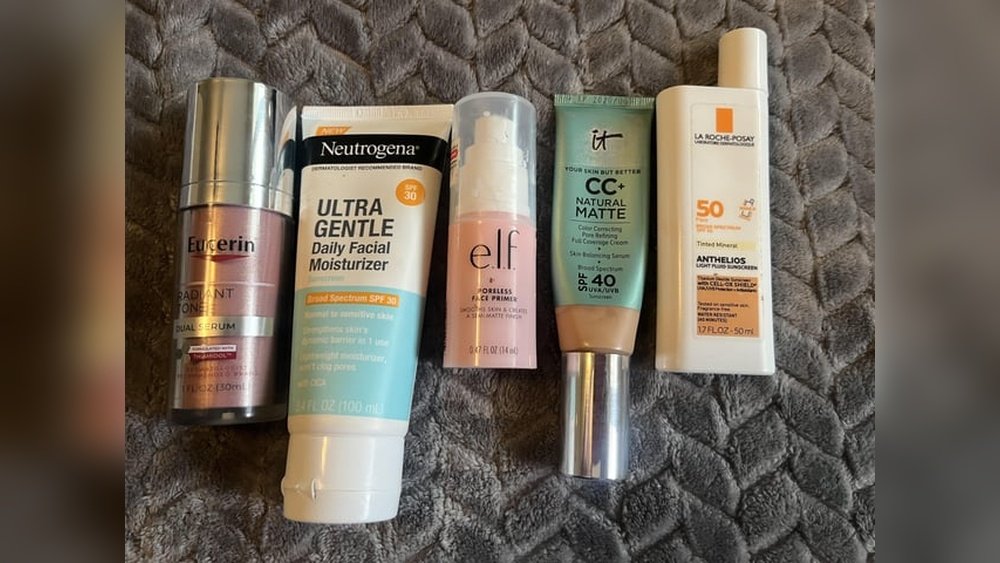You love layering your skincare products to get the best results, but nothing’s more frustrating than seeing those annoying little flakes appear on your skin. If you’ve ever wondered, “Why is my skincare pilling?” or felt like your efforts are wasted because your products just won’t settle smoothly, you’re not alone.
Pilling happens when layers of skincare don’t absorb properly, causing them to roll up and flake off. But here’s the good news: with a few simple changes, you can stop pilling in its tracks and enjoy a flawless, smooth finish every time you layer.
Keep reading, and you’ll discover easy, practical tips to make your skincare routine work smarter, not harder—so you get the glowing skin you deserve.
Causes Of Fabric Pilling
Fabric pilling happens when small fiber balls form on clothing surfaces. These tiny balls, or pills, appear due to friction and wear during use. Understanding what causes pilling helps prevent it, especially when layering clothes. Different fabrics and how they interact lead to pilling issues. Some causes come from the fabric itself, while others come from how you wear or wash the clothes.
Fiber Type And Quality
Natural fibers like cotton and wool pill less than synthetic ones. Short or weak fibers break easily and form pills. Low-quality fabrics with loose fibers also pill faster.
Friction And Wear
Rubbing fabric surfaces causes fibers to loosen and tangle. Layering clothes adds more friction between layers. Constant movement, such as walking or carrying bags, increases pilling risk.
Fabric Construction
Tightly woven fabrics resist pilling better than loosely woven ones. Knitted fabrics tend to pill more due to their looped threads. Fabrics with rough textures catch fibers more easily.
Washing And Care
Aggressive washing damages fibers and causes pilling. Using harsh detergents or washing with rough items worsens the problem. High heat from dryers also weakens fibers.

Credit: www.eucerin.co.uk
Choosing The Right Fabrics
Choosing the right fabrics plays a key role in preventing pilling while layering clothes. Some materials wear better and resist forming those annoying little balls on your clothes. Picking fabrics wisely means your layers will stay smooth and last longer.
Natural fibers and smooth weaves tend to pill less. Knowing which fabrics work best helps you create comfortable, stylish layers without damage.
Understanding Fabric Types That Resist Pilling
Natural fibers like cotton, silk, and linen usually pill less than synthetic fibers. Cotton feels soft and breathes well. Silk is smooth and less likely to create fuzz. Linen is strong and durable. These fabrics keep your layers looking fresh.
Synthetic fibers such as polyester and nylon often pill more. They have tiny loose fibers that rub off easily. Avoid heavy use of these in your base layers to reduce pilling.
Choosing Fabrics With Tight Weaves
Tightly woven fabrics show less pilling. The threads are packed close, so fibers do not come loose easily. Look for fabrics with a smooth surface and dense weave.
Knitted fabrics can pill more because loops of yarn catch and rub against each other. Woven fabrics stay smoother and resist friction better.
Mixing Fabric Types Wisely
Layering fabrics with similar textures reduces rubbing and pilling. Pair soft cotton with smooth silk or fine wool. Avoid mixing rough fabrics with delicate ones.
Heavy fabrics over thin ones cause friction. Use lighter outer layers over sturdy base layers for less wear.
Layering Techniques To Prevent Pilling
Layering clothes is a smart way to stay warm and stylish. But piling can ruin the look and feel of your outfit. Pilling happens when fabric fibers rub and form tiny balls. Using the right layering techniques helps keep your clothes smooth and fresh.
Choosing the right order and handling fabrics carefully reduces friction. This protects fibers and stops pilling before it starts. Below are simple ways to layer clothes without causing damage.
Use Thin Base Layers
Start with thin, smooth fabrics like cotton or silk. Thin layers reduce bulk and friction between clothes. Avoid thick base layers that create pressure points. Thin layers help outer clothes glide easily, lowering pilling risk.
Choose Soft, High-quality Fabrics
Select soft materials with tight weaves for outer layers. Wool blends and high-quality synthetics resist pilling better. Rough or loose-knit fabrics wear quickly and form pills. Investing in good fabrics extends garment life.
Layer Loosely, Not Too Tight
Wear clothes with enough room to move comfortably. Tight layers rub more against each other. Loose layering reduces fabric friction and stress. This simple tip helps keep fibers intact and smooth.
Handle Clothes Gently
Put on and take off layers slowly and carefully. Avoid pulling or tugging hard on fabric edges. Rough handling breaks fibers and triggers pilling. Treat each garment with care to maintain its look.
Wash Layered Clothes Properly
Wash garments inside out on gentle cycles. Use cold water and mild detergents to protect fibers. Avoid overloading the washing machine to reduce friction. Air dry or tumble dry low to prevent fiber damage.

Credit: www.perriconemd.com
Care Tips For Smooth Fabrics
Taking good care of smooth fabrics helps keep them looking fresh and prevents pilling. Smooth fabrics like silk, satin, and fine knits need gentle handling. Proper care maintains their softness and extends their life.
Follow simple steps during washing, drying, and storing to protect these fabrics. These tips reduce friction and wear that cause those annoying little pills. Keep your layers smooth and neat by caring for each fabric properly.
Use Gentle Washing Methods
Wash smooth fabrics on a delicate or gentle cycle. Use cold water to protect fibers from damage. Choose mild detergents designed for delicate clothes. Avoid bleach or harsh chemicals that weaken fabric threads.
Turn Fabrics Inside Out
Turn clothes inside out before washing. This reduces surface friction during washing. It protects the outer layer from rubbing against other items. This step helps keep fabrics smooth and free from pilling.
Air Dry Instead Of Machine Dry
Air drying is best for smooth fabrics. Avoid tumble drying, which causes heat and friction. Lay the garment flat or hang it to dry naturally. This prevents fibers from breaking and forming pills.
Store Clothes Properly
Store smooth fabrics in cool, dry places. Avoid overcrowding your closet to reduce friction. Use padded hangers for delicate items. Fold knitwear gently to keep the fabric smooth and intact.
Product And Maintenance Advice
Choosing the right products and maintaining your clothes properly can reduce pilling significantly. Fabrics and care habits play a big role in keeping layers smooth and fresh. Follow simple tips to protect your garments and enjoy a neat look.
Choose Fabrics That Resist Pilling
Pick natural fibers like cotton, wool, or silk that pill less. Synthetic fibers like polyester or acrylic pill more often. Blends with high-quality fibers can also work well. Check fabric labels before buying layered clothes.
Use Gentle Detergents
Wash clothes with mild detergents designed for delicate fabrics. Harsh chemicals break down fibers and cause pilling. Avoid bleach or strong stain removers on layered garments. Gentle cleaning keeps fabric surfaces smooth.
Wash Clothes Inside Out
Turn garments inside out before washing to protect the outer surface. This simple step reduces friction during washing. Less friction means fewer pills form on visible layers. It helps clothes last longer and look better.
Wash On A Gentle Cycle
Set your washing machine to a gentle or delicate cycle. Fast spinning and rough agitation damage fibers. Use cold water to prevent fabric wear. Gentle washing keeps layers soft and reduces pilling risk.
Air Dry Or Use Low Heat
Avoid high heat in dryers, which can weaken fibers and cause pills. Air drying is best for layered clothes. If you use a dryer, select a low heat setting. Heat control helps maintain fabric quality and smoothness.
Remove Pills Promptly
Use a fabric shaver or pill remover to clear pills early. Do this gently to avoid damaging fabric. Regular pill removal keeps layers clean and new-looking. It also prevents pills from spreading over time.

Credit: www.youtube.com
Frequently Asked Questions
How To Layer Skincare Without Pilling?
Apply skincare from thinnest to thickest layers. Wait 1–2 minutes between each. Use small amounts and pat gently. Exfoliate regularly to remove dead skin. Avoid mixing incompatible formulas to prevent pilling.
How Do I Stop My Moisturizer From Pilling?
Apply skincare from thinnest to thickest layers, wait for absorption, use less product, exfoliate regularly, and pat gently to avoid moisturizer pilling.
Does Pilling Mean Skincare Isn’t Working?
Pilling doesn’t mean skincare fails. It signals product layering issues or skin buildup. Adjust routine and wait between layers for better absorption.
How Do I Prevent Clothes From Pilling?
Prevent clothes from pilling by washing them inside out on a gentle cycle with cold water. Use mild detergent and avoid fabric softeners. Air dry or tumble dry on low heat. Avoid friction by not overloading the washer and separating rough fabrics from delicate ones.
Conclusion
Avoiding pilling when layering takes simple, careful steps. Use thin layers and wait for each to dry. Pat products gently instead of rubbing hard. Regular exfoliation keeps skin smooth and ready. Choose products that work well together. These habits help your clothes and skin stay fresh longer.
Keep these tips in mind to enjoy smooth, pilling-free layering every day.
 Skip to content
Skip to content 